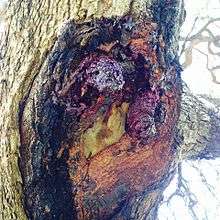Corymbia calophylla
| Marri | |
|---|---|
 | |
| C. calophylla, near Cataby | |
| Scientific classification | |
| Kingdom: | Plantae |
| (unranked): | Angiosperms |
| (unranked): | Eudicots |
| (unranked): | Rosids |
| Order: | Myrtales |
| Family: | Myrtaceae |
| Genus: | Corymbia |
| Species: | C. calophylla |
| Binomial name | |
| Corymbia calophylla (R. Br.) K.D.Hill & L.A.S.Johnson | |
Corymbia calophylla (also known as Eucalyptus calophylla R. Br.) is a bloodwood native to Western Australia. Common names include Marri and Port Gregory Gum,[1] and a long-standing usage has been Red Gum due to the red gum effusions often found on trunks.
It is distinctive among bloodwoods for its very large buds and fruit (colloquially "honky nuts" in Western Australia).
In 2009, Parra-O and colleagues published a combined analysis of nuclear rDNA (ETS + ITS) and morphological characters published to clarify relationships within the genus Corymbia. C. calophylla was found to form a natural group with two other Western Australian species C. ficifolia and C. haematoxylon. They classified the group as section Calophyllae within the subgenus Corymbia.[2]
It is related and somewhat similar to the Red-flowering Gum (Corymbia ficifolia). C. calophylla differs in being much larger (to about 50 metres (160 ft) high in the wild), having very much larger buds and fruit, and having flowers that are usually white to pink instead of red. However, in some areas hybridisation makes identification difficult.
Marri is widely distributed in the South-West of Western Australia, from north of Geraldton (28° S) to Cape Riche (34° S), and inland beyond Narrogin (32°56′S 117° E).
It is found on the Swan Coastal Plain and on the Darling Scarp showing its adaptability to the different environments.
It will grow on comparatively poor soil, but good specimens are considered an indicator of the better agricultural soils.
Uses

Marri timber is increasingly featured in modern household furniture. The timber is honey coloured and has a unique vein structure. However, it is not used in construction as the wood structure exhibits complex faults.
Marri trees played a significant role in Nyoongar culture. The red gum, mayat, which oozes from the tree, contains tannin, which has antiseptic qualities. Mayat was powdered and sprinkled onto open wounds to prevent bleeding, added to water for a mouthwash or disinfectant, mixed with clay and water and used as a medicinal drink for dysentery or used to tan kangaroo skins for cloaks or bags.
The Mari is used to make a variety of objects like doarks (sticks for knocking the tops off Grass Trees [Xanthorrhoea preissii] ), kitjs (spears) and wannas (digging sticks). [3]
Additionally, the blossoms from the Marri can be used as a source of honey, which can be sucked directly from the flower or can be dipped into water to make a sweet drink. These blossoms also attract Ngoowak (bees) and honey can be found in the hollows of eucalyptus branches. These trees also attract birds which nest in the branch hollows, in which eggs can be found to eat. [4] [5]
Notes
- ↑ Holliday, I. and Watton, G. (1980). A Gardener's Guide to Eucalypts. Australia: Rigby. ISBN 0727012576.
- ↑ http://www.joondalup.wa.gov.au/Files/Plants%20and%20People%20in%20Mooro%20Country.pdf
- ↑ http://www.joondalup.wa.gov.au/Files/Plants%20and%20People%20in%20Mooro%20Country.pdf
- ↑ http://www.joondalup.wa.gov.au/Files/Plants%20and%20People%20in%20Mooro%20Country.pdf
- ↑ http://science.uniserve.edu.au/school/curric/stage4_5/nativeplants/gallery/marri/
References
- Boland, D.J.; et al. (1999). Forest Trees of Australia (5th ed.). Collingwood: CSIRO Publishing. ISBN 0-643-06969-0.
External links
- "Corymbia calophylla". FloraBase. Department of Environment and Conservation, Government of Western Australia.